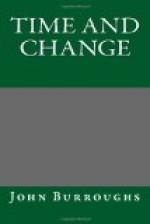The horse appears to have been evolved in North America, true cattle in Asia, elephants in Africa. Can we narrow their line of descent down to a single pair for each? Many forms allied to the horse appeared in Europe and Asia in Miocene times. We find monkeys in different parts of the world in the same geologic horizons; did they all have a common origin?
Life’s apprenticeship has been a long one. The earlier forms of vertebrate life were very large; later they became very small. Nature seems to have experimented with bulk, as if she thought size would win in the race. Hence those huge uncouth forms among the reptiles and early mammals. The scheme did not work well; bulk was not the thing, after all. Most of the gigantic forms became extinct. Then she tried smaller and more agile forms with larger brains—less flesh and more wit. On this line Nature continued to work till she produced her masterpiece in man—a rather feeble and nearly weaponless animal, but with an intangible armory of weapons and tools in his brain that enables him to put all creatures under his feet.
XII
THE HAZARDS OF THE PAST
I
Bergson, the new French philosopher, thinks we all had a narrow escape, back in geologic time, of having our eggs spoiled before they were hatched, or, rather, rendered incapable of hatching by too thick a shell. This was owing to the voracity of the early organisms. As they became more and more mobile, they began to take on thick armors and breastplates and shells and calcareous skins to protect themselves from one another. This tendency resulted, he thinks, in the arrest of the entire animal world in its evolution toward higher and higher forms. These shells and armors begat a kind of torpor and immobility which has continued down to our day with the echinoderms and mollusks, but the arthropods and vertebrates escaped it by some lucky stroke. Now you and I are here without imprisoning shells on our backs; but how or why did we escape? Bergson does not say. Was it a matter of luck or chance? Was there ever a time when the stream of life tended to harden and become fixed in its own forms like a stream of cooling lava, or has the innate plasticity of life been easily equal to its own ends? True, the clam remains a clam, and the starfish remains a starfish; some other forms have carried the evolutionary impulse forward till it flowered in man. Was this impulse ever really checked or endangered? Was the golden secret ever intrusted to the keeping of any single form? and, had that form been cut off, would the earth have been still without its man? These are puzzling questions.




